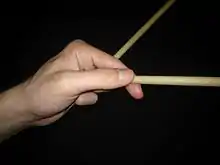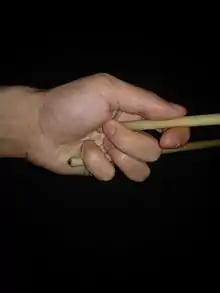Stevens technique
The Stevens technique is a personalized method of playing keyboard percussion instruments with four percussion mallets. While marimba performance with two, four, and even 6 mallets has been done for more than a century, Stevens developed techniques based on the Musser grip (holding two mallets in the hand without crossing the handles - sometimes call the Independent grip that expanded musical possibilities. Leigh Howard Stevens codified his grip and his approach to performance techniques during his studies at the Eastman School of Music in the 1970s and his 1979 book, Method of Movement for Marimba. In this book, Stevens explains that his grip is an evolution of the Musser grip and is sometimes called the Musser-Stevens grip.[1]:8
The grip


In the Stevens technique, the mallets are held loosely. The two outside mallets are gripped with the little and ring fingers; the inside mallets are cantilevered between the flesh of the palm at the base of the thumb and the tip of the middle finger.
Interval changes are accomplished by moving the inside and outside mallets independently of one another, as described in Stevens' book, Method of Movement for Marimba. As the interval widens, the inside mallet rolls between the thumb and index finger, such that the index finger moves from underneath to the side of the shaft, and the middle finger becomes the fulcrum of the cantilever. The outside mallet is moved principally with the little and ring fingers, although the first section of the middle finger follows along and remains in light contact.[1]:14 When properly used, this grip causes no tension on the hand muscles. This grip is primarily used with light mallets and movements that are close to the keyboard. When this grip is used with heavy mallets or with large movements, muscle strain and tendonitis can occur if small changes are not made to reduce stress in the hands.
The essential strokes
The piston stroke is an essential component of Stevens technique. With this stroke, the mallets start in the up position, strike the bars, then return to the up position. The mallets are propelled completely by the wrist, and there is no prep stroke. When changing notes, the piston stroke is modified so that it starts above the first note and ends above the second note, ready to strike.
Strokes are further divided into four categories of motion.[1]:25 Single Independent strokes involve moving the inside or outside mallets singly, pivoting around the shaft of the unused mallet. Single Alternating strokes are used in single note patterns to be played by the same hand, alternating the inside and outside mallets. Double Vertical strokes are used in playing double notes simultaneously by the same hand. Double Lateral strokes are used for fast, rhythmically adjacent notes to be played by the same hand.[1]:24
This method of striking the bars is designed for accuracy and momentum efficiency,[1]:16 since it attempts to eliminate all wasted motion. The piston stroke consolidates the preparation for each stroke into the recovery of the previous stroke.[1]:17
Stevens v. crossed-style
There are three main grips used by mallet players: Traditional crossed, Burton (developed and used by Jazz Vibraphone legend Gary Burton, a variation of traditional crossed), and Stevens-Musser. Both the traditional crossed grip and Musser-Stevens grip are used primarily by marimba players (including Keiko Abe and many marimbists from Asia and Europe) and the Burton grip by vibraphonists.
There are advantages as well as disadvantages to both crossed-style (traditional and Burton) and Musser-Stevens. Crossed-style grips make learning basic mallet control easy and provides a very wide dynamic range with stability while the Stevens grip is harder to master. Additionally, though the Stevens grip is intended to place minimal tension on the hand muscles, the mallets exert greater leverage when they are in motion (since they are held at the very ends), requiring greater muscle control than with crossed-style grips. People with arthritis or similar conditions may not be able to use the Musser-Stevens grip.
As both grips carry advantages and disadvantages, the question of how to hold the mallets must be decided situationally.
See also
References
- Leigh Howard Stevens, Method of Movement for Marimba, 1979